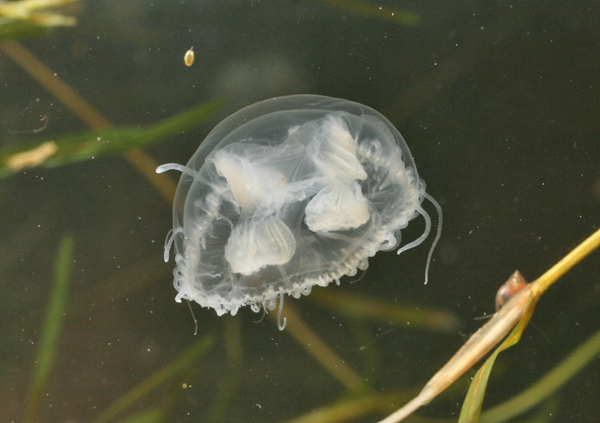Freshwater Jellyfish

Freshwater Jellyfish
(Craspedacusta sowerbyi)
Tags: Aquatic
Identification and Reproduction
Identification:
- Freshwater jellyfish is similar to other jellyfish, it is gelatinous and 99% of its body is composed of water.
- Most of the body is translucent with a white or green tinge.
- It lacks a head, skeleton and does not have distinct organs for respiration or excretion.
- It dimorphic and have two main stages; polyp and medusa morph.
- In its medusa morph it resembles a bell-shape, approximately 20-25 mm in diameter. In this mature form they bear numerous groups of tentacles around the margin of the "bell". The bell is a large stomach-like structure called a manubrium. The manubrium is composed of four distinct radial canals and one circular canal.
- Its polyp form is small, only measuring 2 mm tall, larva-like and lacks tentacles.
- The stinging cells at the end of their tentacles, nematocysts, are unable to penetrate human stings unlike marine jellyfish.
Reproduction:
- Freshwater jellyfish will reproduce asexually when they are in their polyp stage, from budding.
- Polyps are small and collectively make up a colony, attached underwater to vegetation, rocks, and even tree stumps.
- Polyp buds will develop frustule buds that are able to travel short distances and form a new polyp.
- Polyps can also be distributed passively via aquatic plants, aquatic animals and transfer from birds. Polyps can become dormant in winter and when conditions warm they can re-establish into active polyps.
- Medusa buds detach from mature medusa stage adults and will eventually form free-living adult medusas. They will reproduce sexually in this stage from fertilizd eggs.
- Sexual reproduction is very rare, often populations in a region are all male or all female.
Habitat & Ecology
- Freshwater jellyfish is present on all continents except for Antarctica.
- It occupies freshwater lakes, reservoirs, man-made ponds, water-filled pits, rock quarries, algae-filled ponds and rivers.
- It prefers calm waterbodies.
- They are often found at the bottom of shallow waters to help conserve energy and a way to escape predation.
- They consume zooplankton.
- The population size of freshwater jellyfish are somewhat unpredictable.
Impacts
- They can alter aquatic ecosystems.
- They can invade in large populations and consume an abundance of zooplankton.
- May compete with native aquatic species for food and other resources.
Management
- Always clean, drain, and dry aquatic equipment and watercraft before transferring from one body of water to another.
- Report any sightings of the freshwater jellyfish.
Resources
For more information on how to identify freshwater jellyfish refer to the Animal Diversity fact page on Craspedacusta sowerbyi.
BCLSS also provides a data page on freshwater jellyfish here.
Header photo (CrazyBiker 84).



